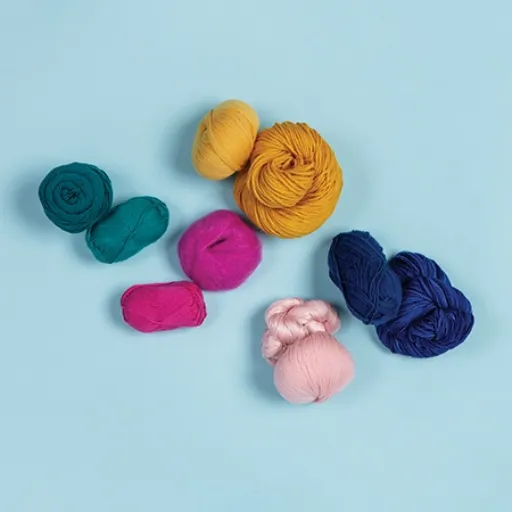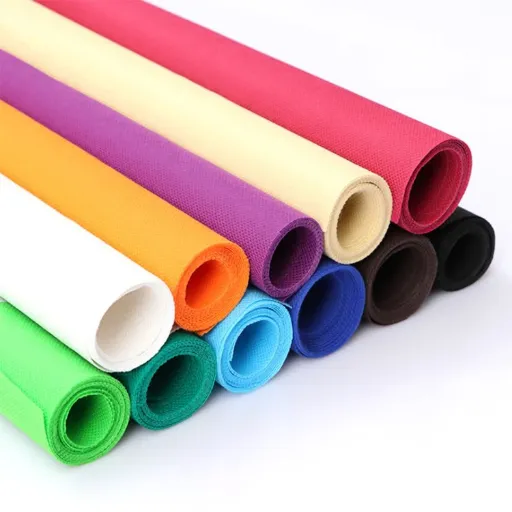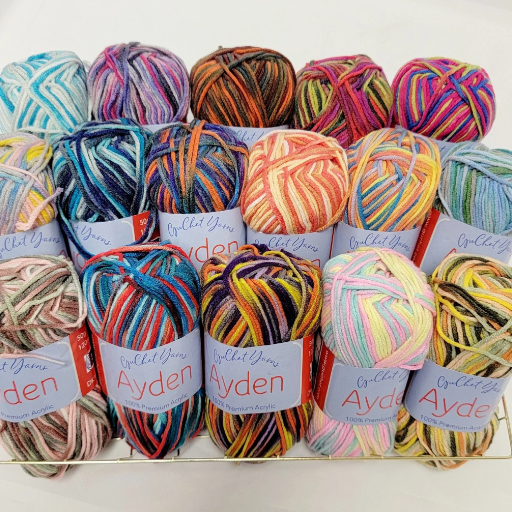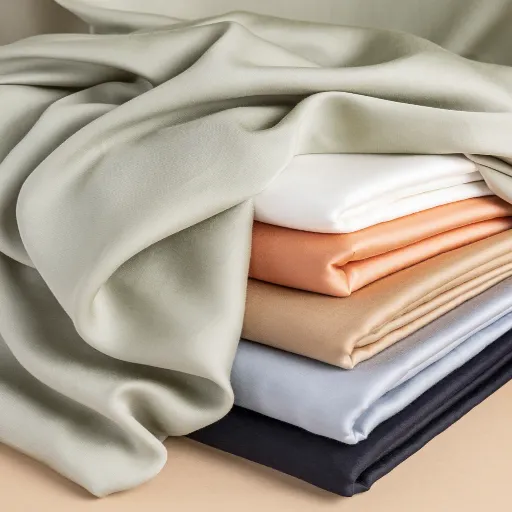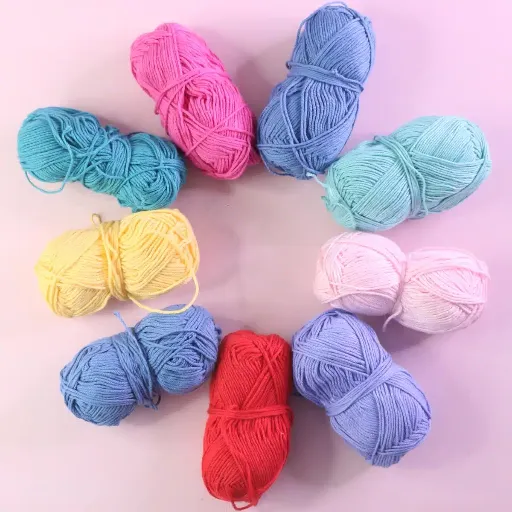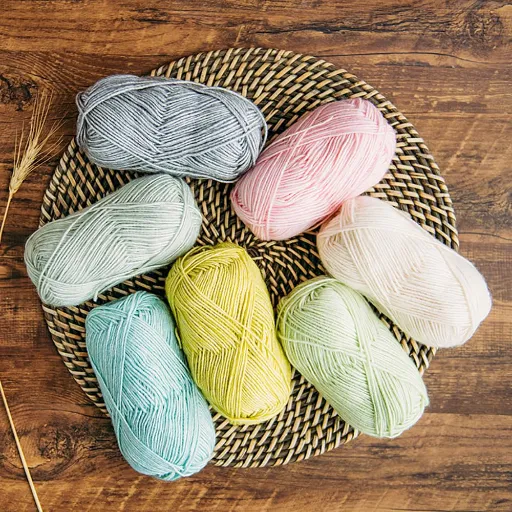Selecting the ideal yarn can be a game-changer if you are working on any fabric-related project or designing new textiles. Polyester and acrylic yarns are two of the most common types of yarns that people use and the main factors of their comparison are durability, versatility, and aesthetics. But how to determine the best one for you? In this post, we will reveal the differences and similarities between these two kinds of yarns by taking a closer look at their properties, pros, and cons as well as applications. This guide is not only for a craftsman with extensive experience but also for someone who is just getting familiar with the world of yarn; it will ensure that your next project is going to be both beautiful and functional. Dive deeper into the pros and cons of these two yarns and find out which one could be the ideal match for your artistic imagination!
Chemical Composition and Manufacturing Processes
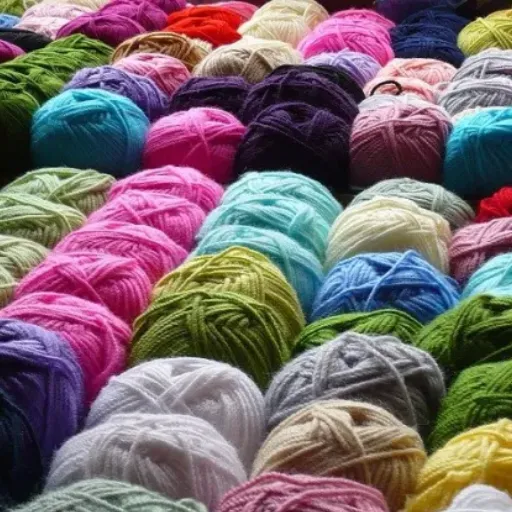
Text view of Polyester Composition
Polyester is a synthetic fiber that comes from the petroleum-based sources, mainly the chemical polyethylene terephthalate (PET). With the help of polymerization, the polyester is manufactured by combining ethylene glycol and terephthalic acid under high temperature and pressure to produce long polymer chains. The fibers created from these chains can be woven or knitted into fabrics. Control over polyester characteristics, like its strength, elasticity, and shrinkage resistance, is possible because of its synthetic nature.
Polyester, with its certain chemical structure, is known to withstand harsh conditions and thus is resistant to the effects of moisture and UV light. One of the characteristics of the polymer is that it is hydrophobic, meaning that water does not get absorbed easily by it, hence it dries quickly. Moreover, polyester fibers are very strong and will keep their form during and after use for long periods. Because of these properties, polyester is widely used not only in clothing like athletic wear but also in such industrial applications as conveyor belts, and even in home furnishings like upholstery and curtains.
Polyester, however, despite its merits, has some drawbacks concerning sustainability and comfort. Being non-biodegradable, it will take a long time to leach out of the environment if not disposed of properly, thus causing pollution. In addition, as it is less permeable to air than natural fibers, people wearing it might feel uncomfortable in hot and humid conditions. However, there is still hope as recycling processes and the development of compostable blends are making denim and other polyester products more eco-friendly at the same time. These innovations are intended to not only reduce its negative impact but also keep the positive properties intact.
Acrylic Composition Overview
Acrylic which is a man-made fiber is obtained from the polymers which result from the polymerization of acrylonitrile. The whole process involves the possibility of creating very long molecular chains which in turn result in a lightweight, soft, and at the same time durable material. To improve the versatility of the material in various applications, acrylic fibers are regularly mixed with other fibers to give them the specific properties of elasticity and strength that they need.
The most important characteristic of acrylic is its wool-like feel that is why it is a widely used alternative to natural wool. So products like sweaters, blankets, and upholstery have acrylic as a main ingredient. Moreover, acrylic is quite resistant to sunlight and aging due to weathering which are the reasons why it is generally used for outdoor applications like awnings and canopies. A great thing about acrylic is that it can easily absorb the very bright and vivid dyes leading to very bright and hard to fade colors of the finished products.
However, acrylic production has a big downside in that it is, to a great extent, dependent on petrochemicals which raises environmental concerns. Recycling initiatives, and biodegradable alternatives are on the market but they are still quite limited compared to their natural counterparts. Hence, it is recommended to have a good grasp of the acrylic’s composition, and its perks and drawbacks so that the consumers can be informed about its use.
Manufacturing Processes for Polyester and Acrylic
Polyester and acrylic are synthetic fibers produced by chemical methods that convert the basic materials into long-lasting fabrics. Polyester is made from oil-based substances, with the manufacturing process involving polymerization, where ethylene glycol combines with terephthalic acid to create polyethylene terephthalate (PET). After the polymer is completed, it is heated, drawn into fibers, and stretched to improve its durability.
Acrylic, in contrast, is generally made from acrylonitrile, which is converted to a polymer through a method called free radical polymerization. The polymer made is dissolved in the solvent and then forced through a small opening (spinneret) to create fibers, which are then solidified and treated to be softer and stronger. During production, additives can be mixed in to help with properties like fading and the fiber’s ability to withstand outdoor conditions.
The two fibers are highly regarded for their wide-ranging uses and good performance but their production is mainly dependent on fossil fuels which raises concerns about sustainability. Manufacturers are gradually looking into green methods, like reusing polyester and making bio-based substitutes for both materials. By directing their attention to innovations and eco-friendly practices, the textile industry strives to reconcile practicality and eco-friendliness.
Common Uses in Textiles and Industries
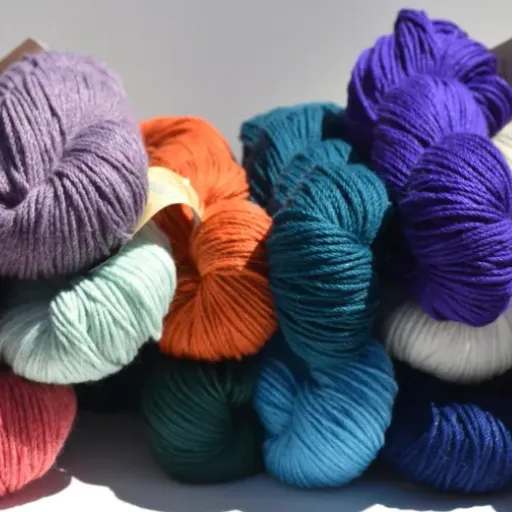
Applications of Polyester Yarn
Due to its toughness, flexibility, and affordability, the polyester yarn is actually very popular in different industries. Some of the main areas of use are as follows:
- Apparel and Fashion: The fabric for the manufacture of clothing is mainly polyester yarn. Its properties like wrinkle free, fast drying and also retaining of color make it suitable for casual, active, and outer clothing. The blended fabrics of polyester and natural fibers like cotton are the ones that are commonly used for everyday clothing and they give comfort along with added durability.
- Home Textiles: Polyester yarn is a major supplier of the home textiles market for bedsheets, curtains, upholstery, and carpets. The durability of polyester yarn, along with its resistance to staining and fading, make it an ideal material for home furnishings that will last a long time.
- Industrial Applications: In the industrial sectors, polyester yarn plays a very important role as it is used in conveyor belts, ropes, and safety equipment. Its exceptional tensile strength and resistance to chemicals make it suitable for heavy-duty applications.
- Technical and Smart Fabrics: The application of polyester yarn in technical and smart fabrics has been opened up by the innovations in the textile technologies. The materials have been applied in sportswear, medical textiles, and even space exploration due to their adjustable characteristics like moisture-wicking, thermal insulation, and antimicrobial finishing. For example, moisture-wicking polyester is an essential part of high-performance athletic wear, the global consumption for such specialized textiles is on the rise.
- Packaging: In line with the sustainability trend, polyester yarn is being used in the packaging of high-strength straps and fabrics for reusable bags and even in the manufacture of other such materials. The recycling compatibility of polyester has also played its part in the growth of its use in this area.
The application versatility of polyester yarn is a clear indicator of its critical importance in both traditional and modern industries. With the continuous innovations in recycling and bio-based polyester technologies, the material has the potential to meet the increasing demand while solving environmental issues.
Applications of Acrylic Yarn
Acrylic yarn is a synthetic fiber that is very soft, cheap and durable. Its properties make it very suitable for various industries such as textiles, home furnishings, and even outdoor applications due to its toughness and a wide variety of advantages.
- Textile Industry: Acrylic yarn is an important raw material for the production of clothing especially winter wear such as sweaters, scarves, and socks. It imitates the softness and warmth of natural wool, and it’s also cheaper than the latter, thus making it suitable for cold-weather garments.
- Home Furnishings: Acrylic yarn is mainly used in blankets, furniture, and carpets because of its feel and being easy to clean. It doesn’t take on stains and doesn’t lose color hence, it’s a great choice for products that have to last in houses.
- Outdoor Items and Industrial Use: Its superb weatherproof quality, acrylic yarn is often used for making awnings, outdoor furniture covers, and marine applications. The fiber’s capacity to endure exposure to sunlight and moisture makes it a good choice despite being relatively expensive for exterior products.
- Crafts and Hobbies: Acrylic yarn is a very popular material for knitting, crocheting and other DIY projects among hobbyists and crafters due to its low price and the range of colors and textures available.
The sustainable acrylic fiber production is constantly evolving with innovations such as recyclable acrylic yarn and bio-based alternatives. The latter not only meets the eco-friendly materials demand but also addresses the environmental issue.
Niche Uses for Polyester and Acrylic
Fibers made from polyester and acrylic are incorporated in several niche applications amidst their general use. Often their durability and versatility push them to be applied in the industries with such special characteristics as heat resistance, moisture-wicking, and lightweight structures. For instance, polyester is a majorly used fabric in the production of sports and active outdoor clothes geared for its capacity to keep dry and shape even in difficult sports.
Conversely, acrylic is widely recognized for its design of warm clothing and blankets because of its insulation qualities. Its lightness and wool-like feel that make it perfect for winter wear. Also, acrylic is used for making wigs and hairpieces and its soft texture and human hair-like quality serve both practical and aesthetic purposes.
Canada goose also employs both materials in domains dealing with technology. Polyester, for instance, is used for making industrial ropes, safety belts, and tire reinforcements due to its tensile strength and resilience. And acrylic also gets into paints and coatings thanks to its ability to create strong film layers and withstand environmental damage. These applications in niche areas point out the flexibility of both polyester and acrylic thus making them necessary materials in a wide array of unusual sectors.
Durability and Longevity Comparisons
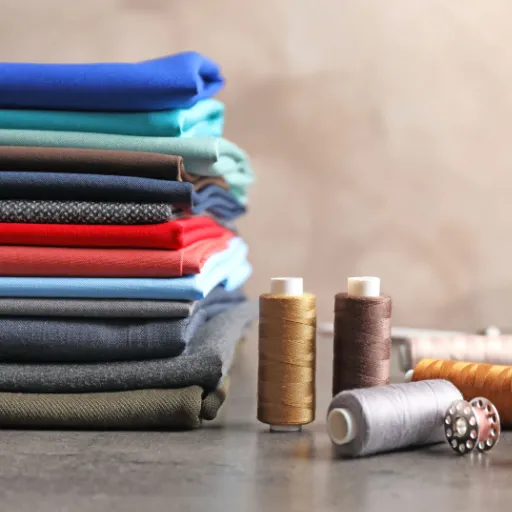
Durability of Polyester Fabrics
Among the features of polyester fabrics their long lasting durability is one, which practically makes them a universal choice in different applications. As a matter of fact, their heavy-duty nature is really one of the main reasons why they are so often used. The polyester fibers have strength as their inherent property, thus they adapt easily to the physical strain for a long time without breaking or thinning.
The durability of polyester has another remarkable factor that is resistance to environmental stressors. Polyester fabrics are extremely resistant to the processes of shrinking, stretching, and wrinkling, so that their shape and structure are preserved through the years. Moreover, polyester is less likely to get ruined by water compared to the likes of natural fibers such as cotton that are almost synonymous with the concept of water absorption and quicker degradation in moist or humid conditions.
What is more, polyester is very difficult to fade and thus, it has become the ultimate option for outdoor and high-visibility applications. Most materials, when subjected to sunlight and ultraviolet rays, tend to lose their strength and quality, but not with polyester, the colors stay vibrant even under such conditions due to its chemical nature. All these factors combine to make the polyester fabrics not just durable but also suitable for many applications such as fashion and furnishings, industrial and outdoor purposes, etc., thus, being no longer a big issue if they are in high demand.
Durability of Acrylic Fabrics
Acrylic fabrics are perfect for their durability, which is their main reason for being chosen as a popular fabric for indoor and outdoor uses. The main reason for this durability is the heavy-duty nature of the fabrics, which stops the wear and tear from daily use and thus preserves the fabrics’ original beauty for a long time. Besides, acrylic fibers are not water-loving at all, which makes them able to survive the most humid or wet conditions and, therefore, the risk of mold or mildew growing crises is completely eliminated.
The fact that acrylic fabrics are extremely resistant to sunlight and ultraviolet (UV) radiation is one of the most amazing characteristics of these fabrics. The fabrics not only lose their color but also become stronger when the light is extremely vigorous and their use in outdoor applications, like shading, patio furniture, and umbrellas, becomes freer. This resistance to UV plays an important role in the prevention of fading and deterioration, hence the material lasts longer without losing its beauty and utility.
Acrylic fabrics are also non-problematic in the sense that they can easily be cleaned and maintained; the best part is that they are resistant to both stains and chemicals. These drawbacks simply mean that the fabrics will last longer and require less effort to keep them looking good. By combining durability, UV resistance, and easy maintenance, acrylic fabrics provide a reliable and versatile material option for numerous industries and applications, from home furnishings to industrial uses.
Care Instructions for Polyester and Acrylic
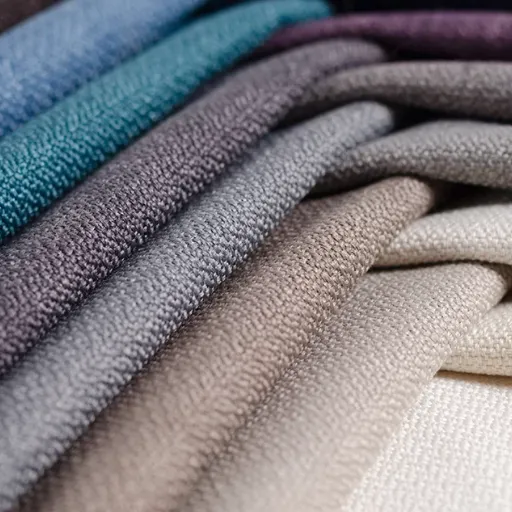
Washing and Maintenance of Polyester Yarn
Polyester yarn is a material recognized and appreciated for its durability and low maintenance requirements however, a proper quality care along with maintenance will really help to preserve the yarn and prolong its lifespan. Here are the washing and maintenance tips which are in detail and are based on the newest guidelines:
- Washing Polyester Yarn: Polyester yarn is a product that can be washed by machine, so it is one of the practical choices for many applications. The use of a gentle cycle along with cold or lukewarm water (30°C to 40°C approximately) is essential to avoid any shrinking or weakening of the fibers. Water that is too hot should not be used, as it will damage the material gradually.
- Detergent Guidelines: Mild detergent without harsh chemicals such as bleach or fabric softeners should be selected. Over time, strong chemicals may lead to the breakdown of polyester’s synthetic fibers and hence reduced durability. An eco-friendly, pH-neutral detergent seems to be the most reliable choice.
- Avoid Overloading: Washing machine should not be overloaded. During washing, sufficient space must be left for yarn or fabric to move easily which will help in the process of cleaning very well.
- Drying Polyester Yarn: Being a synthetic fiber, polyester dries fairly quickly. Tumble drying on low or air drying and letting it cool down before using are good actions to take in order to avoid static electricity build-up or fiber damage. The use of high heat settings in dryers should be avoided, as they can result in melting or permanent creases in the material.
- Ironing and Heat Sensitivity: Though polyester is less prone to wrinkles, you might need to iron the polyester fabric sometimes. Ironing should be done at a low heat setting (under 150°C) and a pressing cloth should be used to protect the fabric. Direct applications of high heat or steam should be avoided because both of them can change the fabric’s texture and strength.
- Stain Treatment: Treat stains beforehand using a mild stain remover or a mixture of water and dish soap as soon as possible. The dab method should be used on the stained area and rubbing should be avoided, as it can make the stain go deeper into the fibers. Pretreatment is easy for most stains due to polyester’s non-porous surface which resists staining.
Washing and Maintenance of Acrylic Yarn
Acrylic yarn is a long-lasting and relatively easy-to-care-for yarn type, however, if you do not take care of it properly it will not last long and your projects will not look so nice. Here are thorough washing and maintenance instructions for acrylic yarn:
- Machine or Hand Washing: Acrylic yarn is predominantly machine washable, but the care label should always be checked first. A common suggestion is to employ cold or lukewarm water (approx. 30°C or 86°F) and a gentle cycle on your machine to prevent needless abrasion or wear on the fibers. When washing delicate stitch work, preserve its structure by considering hand washing.
- Detergent Selection: A very mild, bleach-free detergent should be used in order to keep the vibrant colors and soft texture of the acrylic yarn. Strong chemicals such as bleach should be avoided as they will eventually degrade the fibers.
- Avoid Heat: Acrylic yarn is highly heat sensitive. Due to the synthetic content of the yarn, high temperatures can cause it to lose both shape and softness. When drying, do not tumble dry on high heat, instead use low heat or lay the item flat on a clean towel to air dry. Do not use direct heat like ironing.
- Stain Removal: For stains, treat the area right away with a mild stain remover or a mixture of water and mild dish soap, and use a gentle dabbing motion without rubbing to prevent the stain from going deeper into the fibers. Acrylic yarn does not absorb stains as some natural fibers do, so stain removal is generally easier.
- Pilling Prevention: Eventually acrylic items may acquire tiny fabric pills from friction. Washing the items inside out is a good way to prevent pilling. In case pilling occurs, a fabric shaver or a soft brush can be employed to gently take the pills off without injuring the yarn.
- Data on Durability: Research shows that acrylic yarn keeps its color and even the whole washing and drying cycle of handling as opposed to natural ones, which can fade and shrink. Acrylics have high resistance even to microbial damage, thus they’re the first choice in durable and regularly used items.
- Storage Tips: Store acrylic yarn and finished projects in a cool, dry place. Items should be kept in storage only when they are completely dry to protect against mildew. Use storage bags or containers to shield from dust and pests.
In following these washing and maintenance practices, your creation with acrylic yarn will keep its vibrant color, softness, and quality for years to come.
Best Practices for Longevity of Fabrics
Proper care and handling are very important steps in the assurance of the long-lasting qualities of fabrics. The first step is to always check the labels of care on the clothes to get the specific instructions for washing, drying, and ironing of that item. By maintaining these precautions, the risk of damage is reduced, and along with that the texture and the appearance of the material are kept better. Do not wash too often, as it weakens the fibers gradually and also use gentle cycles for machine washing delicate fabrics.
Storage is the main factor in fabric preservation. Store clothes and fabrics in a cool and dry place to avoid mold and mildew. Instead of plastic which is the sometimes worst option because it can trap moisture and ruin fabrics, use breathable storage options like cotton garment bags. Also, folding can prevent stretching for knitted or heavy materials rather than hanging. Make sure that all items are clean and thoroughly dry before storing to prevent pests from being attracted or stains from being set permanently.
Finally, be aware of the environmental factors that can cause fabrics to decay. Direct sunlight may cause colors to fade and may also weaken the fibers, so it is better to store or dry materials in shaded areas. Avoid using harsh chemicals like bleach, and if necessary, choose fabric-friendly alternatives. By following these practices, you can not only prolong the life of your fabrics but also help them stay as beautiful as ever.
Choosing Between Acrylic and Polyester
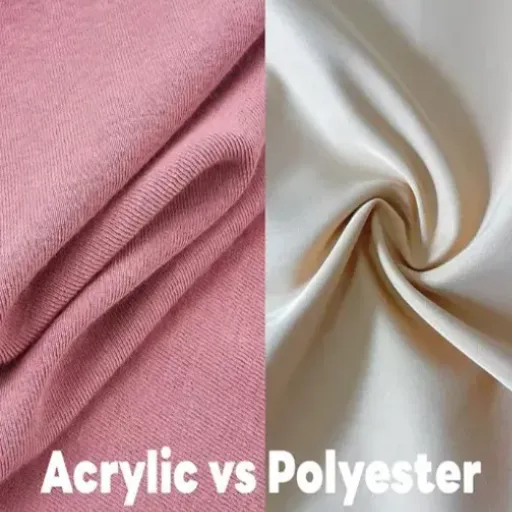
Factors to Consider When Choosing Yarn
The very first thing to consider while picking yarn is the purpose of your project. Different yarn types are more suitable for particular uses such as garments, home decoration, or accessories. For instance, soft and herbal yarns like acrylic or cotton can be used in making clothing,while thicker options like polyester or wool blends can be ideal for items that require durability like bags or rugs. Choosing the right yarn for your project means that the results will be great both in functionality and appearance.
Another aspect that needs to be looked into is yarn’s texture and weight. Yarn weight influences thickness and how your project will feel and drape when finished. Lightweights such as fingering or sport yarns produce intricate and fine results, while bulky or super bulky yarns lead to quicker and sturdier creations. The texture of yarn, for instance, whether it is smooth, fluffy or textured, also plays a part in the overall look of the finished piece. Swatching can be helpful in determining if the weight and texture of a yarn are in sync with your projection.
At last, take into account your proficiency and upkeep requirements. Newbies might find working with medium weights like worsted yarn easier. This is because yarn offers better control and visibility of stitches. For long-term maintenance, consider how the yarn will stand up to washing or wear. Machine-washable yarns like acrylics and polyesters are low-maintenance while natural fibers like wool and alpaca may need more careful handling. Weighing these factors will not only lead you to the right yarn but also guarantee a smooth crafting journey.
Practical Tips for Different Applications
Comfort and durability are the main features to look at when selecting yarn for clothing. The use of natural fibers such as wool or cotton for sweaters and scarves can be done without any doubt because these two material combinations have excellent qualities of heat retention and airflow. The addition of acrylic may also help to make them more resilient and, thus, easier to wash. Be sure to follow the care instructions on the yarn label so that the finished product can be easily maintained over time.
For home decorations, bulky yarns are a perfect choice compared to other yarns, since the latter will just have to spend a lot of time in the making and will be very hard to use because of their little strength. Natural fibers like cotton and wool seem to be the softest; however, they do not last as long as synthetic fibers like polyester and acrylic. They are particularly well suited for home décor projects because they can withstand being washed and are generally super resistant to wear and tear.
If you are making small items like hats, gloves, or bags, go for yarns with good rebound and strength. Wool with synthetic fibers mixture gives the necessary expansion and toughness, therefore, the resulting product will keep its form. For those pieces that call for elaborate stitch-patterns, use lighter yarns like sport or DK which allow better stitch definition thus giving your design more than one properly displaying it.
Consumer Preferences: Acrylic vs Polyester
Acrylic and polyester are frequently discussed and compared regarding their respective issues of affordability, durability, and versatility in the market of fabrics. The reason for acrylic’s massive acceptance is its characteristics of being soft and warm, thus making it a favorite fabric for cozy items such as sweaters, scarves, and blankets. Its lightness gives it the sensation of natural fibers like wool, which attracts consumers who seek comfort at a reasonable price. Furthermore, the dyeing process is easier with acrylic fabrics leading to a widespread and bright palette of colors for consumers to choose from.
In contrast, the consumers usually give high marks to polyester due to its toughness, ability to resist wrinkles, and being easy to maintain. Polyester is the first choice for consumers in the making of products that need strong materials such as sportswear, outerwear, and upholstery. The water resistance and fast-drying characteristics of polyester make it the best choice for both active social life and outdoors. One of the key differences between acrylic and polyester is that while the latter has a smoother feel, it also has a higher resistance to pilling which contributes to its durability and practicality.
In the end, whether to go for acrylic or polyester really depends on the user’s specific requirements. Acrylic is perfect for those products that mainly focus on offering warmth and softness, while polyester is typically the choice for its strength and performance in tough conditions. Although both materials have their unique advantages, they still coexist in the market, and their popularity lasts across different categories and lifestyle segments, thus covering wide-ranging consumer preferences.
Frequently Asked Questions (FAQ)
Q: Are polyester and acrylic the same thing?
A: Not at all, polyester and acrylic are two different materials. They are both man-made textile fibers but with contrasting component materials—polyester is produced from the polyester resin, whereas acrylic is made from the polymer of acrylic acid.
Q: What separates polyester from acrylic as far as fabrics are concerned?
A: The main differences between polyester and acrylic fabrics lay in their respective characteristics and areas of application. Polyester is rough, less breathable, long-lasting, and water-repellent, so it is used mainly in the production of outdoor and athletic wear; whereas, acrylic is the opposite—soft, more breathable, and a wool alternative being one of the principal uses.
Q: Is it possible for me to use acrylic instead of polyester?
A: Acrylic can be selected over polyester for particular applications, especially when softness and warmth are the main factors to consider. However, in the case of durability and resistance to wear and tear, polyester is often thought to be the better one.
Q: What is the comparison of recycled polyester with virgin polyester?
A: Recycled polyester is another icon of environmentally friendly nylon made out of post-consumer plastic waste, whereas virgin polyester is produced out of new raw materials that is a less green production process. Both types give the same genre of polyester characteristics but the recycling method makes the recycled type more sustainable.
Q: Do both acrylic and polyester fibers have the same suitability for moisture-wicking?
A: When comparing their moisture-wicking characteristics, acrylic generally comes second to polyester. Although acrylic retains less water and is less effective in this respect, polyester can absorb water and evaporate it almost instantly, thus it is perfect for athletic garments.
Q: Which one should I prefer for my outdoor activities, acrylic or polyester?
A: The choice of fabric for outdoor activities often falls on polyester as it is the more durable option and can endure wear and tear. Besides, it provides moisture-wicking features that help to keep you dry.
Q: Is there a color fade with acrylic yarn in comparison to polyester?
A: Yes, there might be a tendency for acrylic yarn to produce color fading in a shorter lifespan than polyester does. Color retention of polyester is very strong, thus its application in producing long life clothes and textiles is very popular.
Q: What is the impact of polyester production on its properties?
A: The synthetic fabric made from polyester production is normally more durable and resistant not only to UV but also to color fading. This is another reason for placing polyester among the top for products requiring long-term outdoor use.
Q: Is acrylic a better alternative to polyester for knitwear?
A: Acrylic is the fiber of choice for knitwear because of its inferior softness and warmth; however, polyester is the second choice for its robust character. The selection of fabric mainly depends on the characteristics of the product, be it softness or durability.
Q: What factors do I need to consider when choosing between acrylic and polyester?
A: If you consider wearing it, think of acrylic or polyester, of what you are going to use it for. If you are after a gentler, cozier option, choose acrylic. On the other hand, if you are looking for a hard-wearing and moisture-wicking fabric, the better option is polyester.
References
- Big Z Fabric – Two Common Fabrics: Acrylic vs Polyester – Discusses the differences in softness, durability, breathability, and warmth between acrylic and polyester.
- Textile Yarn – The Key Differences Between Acrylic and Polyester – Highlights the wool-like texture of acrylic versus the durability and versatility of polyester.
- Thai Polyester – Difference Between Polyester Yarn and Other Synthetic Yarns – Explains the chemical composition and unique properties of polyester and acrylic.








